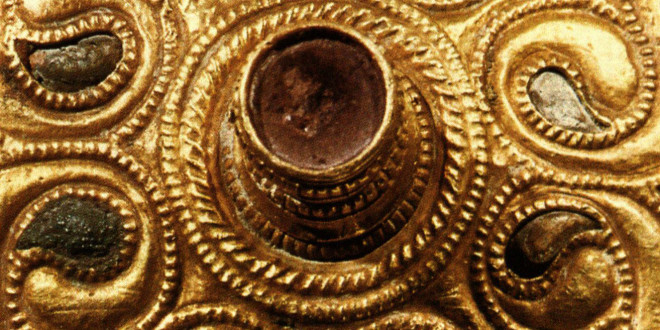Every few days or so I get a question from someone about purchasing physical gold. Randall Oliphant of Barrick Gold recently said in an interview that most new gold production goes into the jewellery market, predominantly in India, and talked about the gold business benefiting from a jewellery marketing campaign. Walking down a typical Mumbai or New Delhi street would you then expect to see women laden down with bangles? Of course not, and this is where the fundamental error in understanding spawns silly misguided attempts by the World Gold Council and others to “promote” gold by using fashion models and such. Indian jewellery is usually 24 carat gold and is not meant to be worn, except on very special occasions. On her wedding day a typical middle class bride wears nearly 32 ounces of gold. Family wealth is passed along maternal lines in the form of golden dowries. Wedding guests also give gold coins as lucky wedding gifts. Gold is deeply embedded in the Indian culture. No need to advertise gold here, it’s appreciation is almost instinctive. It’s not so much for adornment as for investment. As the whole of India moves upscale, the demand for gold is increasing.
Contrast: In the “enlightened” West, if you were to ask most people on the street the price of gold you would probably be surprised that most think it is worth much more than it truly is. Try it yourself. And, if you showed them a standard 400 oz bar all of them (bar none) would estimate its value higher than it really is. A few will say “a million dollars”. Gold is also deeply embedded in the western psyche, though perhaps as “repressed memory”. But it lurks there in the back of our consciousness, which is why films like “The Treasure of Sierra Madre”, “Goldfinger”, and “Kelly’s Heroes” were such big hits. That’s why rubbish gold-fill jewellery in the mall sells – people have an inaccurate idea of its value, but they know gold is valuable. Not many people are even aware that they can purchase and own a gold coin or a gold brick. Would a “Diamonds are Forever” De Beers-type ad campaign change this? Probably not. Ostentatious display is considered vulgar, and the idea of wearing thick heavy jewellery “on those special occasions” just won’t fly. Besides, the most popular jewellery in the USA is 10 carat (only 42% gold by weight) and that is unlikely to change. To my mind a much more effective campaign would be to target the small investor. The demand for gold runs counter-cycle to normal commodity behaviour, and actually increases when the price increases. You will see misinformed media stories forecasting doom for the gold market “when gold gets too expensive for jewellery fabricators”, but history has shown that any slack in demand is always taken up by investment. When the gold price rockets, the media reports of the lengthening queues at the gold wicket in the bank will be the best advertisement. This will happen, in time. For now, there’s a major disconnect between the subconscious perception here in the West that “gold is valuable” and the belief that is front and centre in Eastern Europe and the whole of Asia – “gotta have some for a rainy day”. Private gold ownership in Latin America is shockingly low, though gold ownership in countries like Mexico and Peru which issued their own coins was once strong. The lust for gold was the driving force that sent the conquistadores far and wide, but now what is left sits in museums and cathedrals, and what is produced is exported.
Promoting gold in Asia is like preaching to the converted. Publically promoting gold in the USA will not be effective unless at the same time war is publically declared on paper currency. The mainstream media won’t have the guts to do that – not in the short term anyway. But, the World Gold Council could do no worse than to run a continuous series of ads in the major newspapers of Latin America, exhorting their wealthy citizens to forego that trip to Disneyworld this year and sock the money away in gold, just in case your government stops doing its job. Could there be no better alternative for wealthpreservation? Especially when the US dollar is looking shaky? Could there possibly be a more potentially receptive audience? It seems that every few years one or other Latin American country has their currency devalued into oblivion. With the recent changingof- the-guard at the WGC, perhaps we’ll see some aggressive marketing along these lines.
There has been a lot of buzz on the internet in recent weeks about gold confiscation. Could it happen again in America? I doubt it, though it might be tried. As one person wrote on a forum, “They’ll have to confiscate my gun before they confiscate my gold”. If they tried to confiscate gold there would be a Black Market in the US the likes of which have not been seen since the days of the Bootleggers and Speakeasies during Prohibition. Remember the unheeded calls to invest in the stock market in the immediate days after September 11th, in “the name of patriotism” ? The American government no longer occupies the moral high ground that it did in 1933. We’ve impeached Nixon and Clinton since then.
I don’t know if the following story is apocryphal or true. It comes from “Silver” by Thomas Patrick Mohide, pg. 282
“On December 31, 1981, Trans World Airlines lost a shipment of Krugerrand gold coins destined for the Franklin Mint. Gold was selling in the U.S. for U.S. $399 an ounce that day. The insurance company said that the “official” price of gold in the U.S. was U.S. $42.22 an ounce. The Supreme Court of the United States decided that $42.22 an ounce was indeed the “official” price in the U.S. of gold bullion last set in 1973″.
The author suggests that if gold is confiscated, the US government may redeem it at the “official” price. I don’t personally believe that the government can realistically do anything about the gold already held by Americans, except by violating several parts of the Constitution. In former times they could perhaps steam roll legislation sanctioning confiscation through the Senate and Congress “in the name of patriotism”, but not now. And, realistically, it’s a much different world now that most U.S. dollars are actually held outside of the USA. The fear is not so much that Americans will flock to gold and tank the US buck but that foreigners will. After all, the US gov’t can’t confiscate Chinese or Russian gold. (For those interested in the fate of the dollar, see an excellent article in the May 20th issue of Business Week, “The Greenback’s Setback: Cause for Concern?”)
You’ll hear much from the gold-knockers about the fact that gold does not earn interest – the dog-eared reason for its sales by Central Banks. A hundred gold Eagles squirrelled away in your sock drawer won’t earn you any interest, but your sock drawer isn’t about to declare insolvency. The gold will be there, under your control, and, should you meet with an untimely demise, it will be there for your children and grandchildren also. A friend of my brother bought my niece one share of Nortel Networks on the day she was born (this has become a family joke). She’s now six, and that share is virtually worthless. In fact if she wanted to sell it, it wouldn’t cover the brokerage fees and commission. Now, if he’d bought her a shiny Maple Leaf, she’d still have it when she turns 21, and he’d be a fondly remembered hero. Instead, he’ll probably not be remembered at all……
How much of your savings should you put into gold? I’ve heard advice from “five percent” to “virtually all of it”. This is of course a case for personal preference and depends on your financial situation.
In certain jurisdictions large transactions are reported to the government “to prevent money laundering”. You’ll be asked for a picture I.D. in these cases. However, in many countries there are no forms to fill out and nothing to declare. If you are buying bullion it’s important to make sure it’s “4 nines”, 0.9999 fineness. Older bars can be 3 nines or even .995 or .997, in which case when you sell them you will be hit with a “refining charge” – a penalty.
Many people prefer gold coins for investment because they are more portable, more liquid, and don’t carry serial numbers (more anonymous!) If you are buying for the sake of owning gold, your best bet is the so-called “bullion coins”: Canadian Maple Leafs, US Eagles, Austrian Philharmonics, Australian Nuggets or Kangaroos, and South African Krugerrands to name the most popular. Most of these come in fractional values, and all are legal tender – which means that it is a crime to make counterfeits. Buying collector’s coins is like buying a piece of artwork, rare stamps, or antiques. Lots of fun, but be aware there may be quite a markup in price from the contained gold value. I would stay away from recent commemorative coins, proof coins, and Franklin Mint medallions. They are difficult to liquidate, have very little rarity value, and you may even be offered less than the gold value when it comes time to sell. The bullion coins all come with a small “premium”, which is the markup in sales price from the value of the contained metal (bar gold of course has no premium attached). The premium derives from a combination of factors – there’s the cost of minting to consider, the profit for the distributor, and demand for the more aesthetic coins. The Australians first produced a series of coins featuring famous gold nuggets – interesting but not very aesthetic – a few years later they changed to kangaroos. Some animal designs are considered lucky in the Orient; the Chinese produce the 1 oz panda. Old President Kruger on the Krugerrand never could have won any beauty contests (and certainly wouldn’t have approved of them). His portrait is the same as that on the “Kruger Pounds”; the gold sovereigns minted by the Boer republics in the 1890’s. If you were to purchase 20, 1/20th ounce Maple Leafs you’d pay a higher total premium than 1, 1 oz coin. This is because of the cost of mintage. If you think the day will come when we will have to pay for our groceries in gold, you might want a stash of small fractional coins.
US gold “Eagles” come in 1 oz., ½ ounce, 1/4 ounce and 1/10th ounce sizes. They are 22 carat gold; an alloy of gold and copper which appears reddish-yellow. Though the coins contain the amount of gold stated on them they aren’t pure. They are .9167 fineness and the same fineness as the Krugerrand. The copper alloy makes the coins less liable to wear. Eagles are the bullion coins preferred by Americans. The bright yellow Canadian Maple Leaf though remains enormously popular, and was the first .9999 bullion coin produced. Both are saleable worldwide. The Maple Leaf, Kangaroo and Philharmonic are all 24 carat, or .9999 fineness.
Depending on what you buy and where you make your purchases you can be liable to State Sales Tax, Provincial Sales Tax (PST), Value Added Tax (VAT) or Goods and Services Tax (GST). In the European Union, per directive 98/80/EC “Special Scheme for Investment Gold” all bullion coins became VAT exempt on January 1, 2000. In Canada, GST is payable on all coins of less than .9950 fineness, (including Eagles and Krugerrands). PST is chargeable on all coins, except in Alberta, British Columbia, Quebec, NWT and the Yukon where the >.9950 fineness exemption also applies. In Australia, GST applies to all coins of less than .9950 fineness, and there is no PST.
In the USA, the rules are highly variable. The states of Montana and Oregon are still state tax exempt. Elsewhere, it may depend on the quantity you buy whether you are liable to state tax. Many states don’t charge tax on total purchases in excess of $1,000. Some states don’t tax gold purchases at all. There are also things called “Use Law” in many states that forbid you to purchase in a tax free state and import into your home state. Not exactly easy to enforce. If you’re worried about that kind of thing seek legal advice.
An interesting aside that is on the “FAQ page” on the US Mint website.
Q.:“Why is the United States minting bullion coins?”
A.: “As mandated by Congress (31 U.S.C. section 5112), the United States mints bullion coins to give gold, platinum and silver purchasers the world over the opportunity to buy American coins backed by the United States Government”.
What a joke!!! BACKED by the US Government?! Since when has gold needed to be backed by anyone?? Or, are they cheekily suggesting that because a 1 oz gold Eagle is stamped “Fifty Dollars” that if the POG should suddenly and cataclysmically plunge to $20 per ounce they will courageously and unselfishly guarantee you’ll get a green piece of paper with President Grant’s picture in return for it? Elsewhere on their website they say, “The legal tender, or face value is largely symbolic”. Those who are worried about gold confiscation, and being paid $42-and-change per oz. may be comforted to know that the Department of the Treasury acknowledges that their own bullion coins have an internationally market-determined price.
So, that’s all I know about buying physical gold…….for more information consult one of the many folks who specialize in this business. You’re best to deal with those who have been in the game for some time and have a track record. See if they’re accredited and licenced, or approved by the Better Business Bureau. There have been fakes sold by on-line auctioneers, so make sure that you are dealing with someone reputable.
And now for something completely different……….
Porphyry copper-gold deposits
These are major contributors to new gold supply, yet most investors know very little about them. I’ve had a couple of questions about Metallica Resources Inc. recently, who announced on May 7th, the results of a 970 metre vertical hole mineralized from top to bottom on its El Morro Project in Chile. We’ll get to that in a moment…..
Just to explain briefly what a porphyry copper-gold deposit is – these are typically low grade, bulk tonnage deposits which can only be economically mined using economies of scale and relatively low cost open pit techniques. In the unoxidized ores, the gold occurs within copper and iron sulphides and cannot be mined by itself. Consequently, copper-gold mines only do really well when both the copper and gold prices are both healthy, but once the capital costs of building the mine and infrastructure are recovered these mines can carry on for years, weathering the storm when either gold or copper are lower in price.
Porphyry bodies in ideal cross section look like giant, upright lightbulbs. They can have considerable vertical extent. They are made up of varieties of granite, formed by the melting of the leading edges of oceanic plates, as they dive beneath continental masses, inboard of collisional zones. They’re usually found a few hundred kilometres from the coast. Porphyry copper deposits are found in the western USA, British Columbia, and the west coast of South America, as well as in the Philippines and Indonesia. The copper sulphides typically occur in crisscrossing networks of quartz veinlets within and throughout the porphyry rock. “Copper-gold” porphyries are rarer than copper porphyries – the designation is arbitrarily set at >0.4 g/t Au. To recover the metals porphyry ore is crushed and then most often processed using flotation. The sulphide “concentrate” which is floated off is then shipped to a smelter where gold and silver are recovered in addition to the copper. It’s important to recognize that cyanide heap leach-type recovery such as used at many gold mines, is inappropriate for this type of ore.
Now, back to Metallica’s press release.
On the La Fortuna property, Metallica intersected 970 metres of mineralization – the entire drill hole. The hole graded 0.65% Cu and 0.53 g/t Au. It is the deepest hole to date, and bottomed in mineralization, which therefore is still open to depth. The hole bottomed 400 metres below the already established inferred resource of 410 million tonnes which grades 0.61% Cu and 0.51g/t Au.
The El Morro Project comprises four adjacent properties: La Fortuna, El Morro, El Negro, and Cantarito. Mineralization has been intersected in drilling on all 4 properties. The first three are copper-gold porphyry plays, Cantarito is a high grade gold prospect.
Noranda is operator and can earn up to 70% interest in the project by completing work commitments of $US10 million and making a cash payment of $US10 million by September, 2005. Noranda is also required to complete a bankable feasibility study by September, 2007 and provide 91% of the capital required for the project.
According to their last annual report, Newmont Mining, Royal Precious Metals Fund (the top performing Canadian precious metals fund) and Fidelity Investments are big shareholders.
There’s lots of work still to be done, but this deposit could turn out to be huge, and potentially a big money spinner for both Noranda and Metallica.
To see how this compares with other porphyry copper-gold deposits; the granddaddy of all mines is Kennecott’s Bingham Canyon, which has been in production since 1906 and is the world’s second largest manmade excavation (I think the Panama Canal is first). The mine is almost 4 kilometres wide and 1 kilometre deep. I don’t have any recent numbers, but Bingham Canyon’s grades in 1999 were 0.57% copper, 0.42 g/t gold, 2.77 g/t silver and 0.042% molybdenum.
Perhaps the richest copper-gold porphyry is Freeport-McMoran’s Grasberg in Indonesia, which grades 1.1% Cu, 1.04 g/t Au, and 3.4 g/t Ag in a total resource of 2,515 million tonnes of ore. The orebody has been defined over a 1,700 metre vertical distance top to bottom and is still open at depth.
Bajo de la Alumbrera, Argentina, is a very respectable mine, with 694 million tonnes at 0.51% Cu, and 0.66 g/t Au. Batu Hijau in Indonesia contained 914 million tons of 0.525% Cu and 0.403 g/t Au, with an additional 580 million tonnes at 0.323% Cu and 0.171 g/t Au not in the reserve category. It’s a big source of gold production for Newmont who hold a 45% interest. This year their expected share of production is 180,100 Au ounces, plus 293 million lbs. of copper.
Major copper producers have been cutting back their production lately due to generally lacklustre base metal prices. I’m not particularly bullish on the prospects for copper, but should the gold price rise significantly it could more than offset any drop in copper value in a deposit such as this. The development decision for a copper-only deposit hinges on a magic balance between grade and size (tonnage). When there’s gold as well, there’s more room to manoeuvre and the economics aren’t as tight. Open pit mines typically are limited in depth to about 300 metres or so – to go deeper in an open pit scenario means to shift a lot more waste rock than would be normally economically feasible. The key to the future of this deposit will be the gold price. There’s lots of room for the resource numbers at La Fortuna to increase significantly. With higher gold prices a major pushback of the pit walls to get at and scoop up the deeper ore is a possibility later in the life of a mine.
Geology 101
You’ll often see a phrase in a mining company’s press release that goes something like this, “regional exploration has identified a coincident silver and gold anomaly that extends for 4 kilometres”. What does this mean? The last place you may have heard “anomaly” was from Capt. Jean-Luc Picard on Star Trek. It’s not complicated though…all it means is something observed that “stands out” from the background, usually over a geographic area. The anomaly typically has magnitude and size. For instance, a normal run-of-the-mill basalt rock contains only about 1 to 3 parts per billion (ppb) gold, but in an alteration zone it may contain 100 ppb, and in a mineralized zone it could contain 5,000 ppb. The last two are both “anomalous”, but the typical or “background” value is simply normal and of no interest.
Geologists will often get excited when certain suites of chemical elements are anomalous together. They are then said to be “covariable”. For instance, mercury, arsenic, antimony, gold and silver, when all anomalous together are powerful evidence of epithermal-type gold mineralization; especially if you are in places like Peru. In similar fashion, copper, cobalt, nickel, and palladium when anomalous together might indicate a nickel-rich massive sulphide in the vicinity; especially if you were in the Canadian Shield. I recently received back a set of assays of hard quartz vein material that were anomalous in vanadium, cobalt, tungsten, and iron. A geologist might scratch their head at that, but it was clear evidence that the soft iron crusher and the tungsten carbide grinding plates in the lab had been worn by the hard quartz and had contaminated the samples.
Experienced geologists can usually cast their eyes down columns of numbers in lab reports and intuitively spot anomalies, but there are also sophisticated statistical computer programmes that do the same job. One final note, had the management of Bre-X demanded that a certain number of drill samples be routinely submitted to multielement analysis, the fraud never would have worked. You can salt samples with the right amount of gold to make results appear plausible, but because of the phenomenon of covariance it would be darned near impossible to doctor the chemistry of the rock itself in any believable way.
 Straight Talk On Mining Insights on mining from economic geologist Dr. Keith Barron.
Straight Talk On Mining Insights on mining from economic geologist Dr. Keith Barron.




